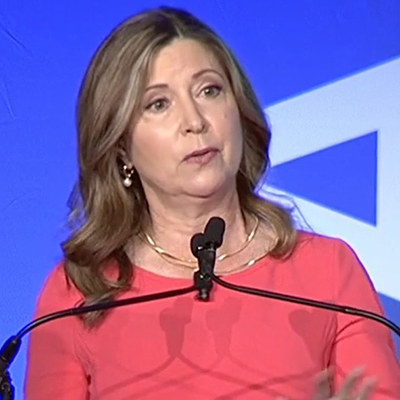
A recent poll of chief nuclear officers at the Nuclear Energy Institute’s (NEI) member utilities found that they plan to add 90 GW of nuclear generation to the U.S. grid, with the “bulk” of that capacity coming online by 2050, CEO Maria Korsnick said Tuesday.
That level of generation would double U.S. nuclear output and does not include “the growing list of utilities who are new to nuclear and demonstrating interest in advanced technologies,” she said in a State of the Industry address at NEI’s Nuclear Energy Assembly in D.C.
 Maria Korsnick, President and CEO of the Nuclear Energy Institute | Nuclear Energy Institute
Maria Korsnick, President and CEO of the Nuclear Energy Institute | Nuclear Energy InstituteKorsnick expects the new U.S. nuclear fleet to include “some” small modular reactors (SMRs). Supporters of the SMR approach, which limits traditionally large generating capacities to under 300 MW, say it offers the possibility of nimble nuclear deployment.
She also sees those new smaller plants that are based on advanced technologies, together with an expansion of existing nuclear technology, as an important part of addressing climate change.
“Nuclear is the key to unlocking a zero-carbon future,” she said, adding that she has observed a “sea change in the perception of nuclear energy … as an indispensable tool for driving down emissions.”
A growing vision for SMRs moves nuclear beyond ensuring grid reliability to helping decarbonize hard-to-abate industries, such as oil and gas chemical manufacturing, steelmaking and production of synthetic materials.
“Advanced reactors are the solution that they’ve been searching for,” Korsnick said. “They can provide the reliable, cost-effective carbon-free generation needed to decarbonize their supply chains, and they enable manufacturers to sell to companies like Ford, GM, Tesla and others who are committed to a lower-carbon future.”
In addition, she said that manufacturing and transportation sectors could decarbonize with hydrogen generated from the off-peak capacity of nuclear reactors.
Credit for ESG
To realize a role for nuclear in a decarbonizing the economy, the industry must navigate a future where investors are increasingly screening for environmental, social and governance (ESG) factors.
“Nuclear should be getting credit for ESG,” Korsnick said. “I’d like to tell you that it’s that simple, but it’s not, and there are some financial institutions that look at nuclear and look at ESG, and they struggle to say that nuclear actually supports that.”
As an example of the challenge, Korsnick pointed to the current controversy over inclusion of nuclear in the EU’s sustainable finance strategy (or “green taxonomy”). ESG investors are watching the EU’s strategy as an important standard for defining what makes a green investment.
The EU issued rules in April 2021 for activities that can be defined as “green,” but it chose to wait on its decision about whether to include nuclear and natural gas on the list. A final decision for the two resources is due in early July.
“It’s really important that we all stand up for nuclear … because one of the things we need to unlock is financial investment,” Korsnick said.
The U.N.’s 27th Climate Change Conference of the Parties (COP) in Egypt this fall is an opportunity for industry members to represent nuclear’s potential for decarbonizing the economy, according to Korsnick.
“At COP 27 … and every other forum where official critical decisions are being made about our climate and our energy future, we need to be crystal clear,” she said. “If we don’t commit to the next generation of nuclear now, our hesitation will cost our electric grid, our economy and our environment.”


